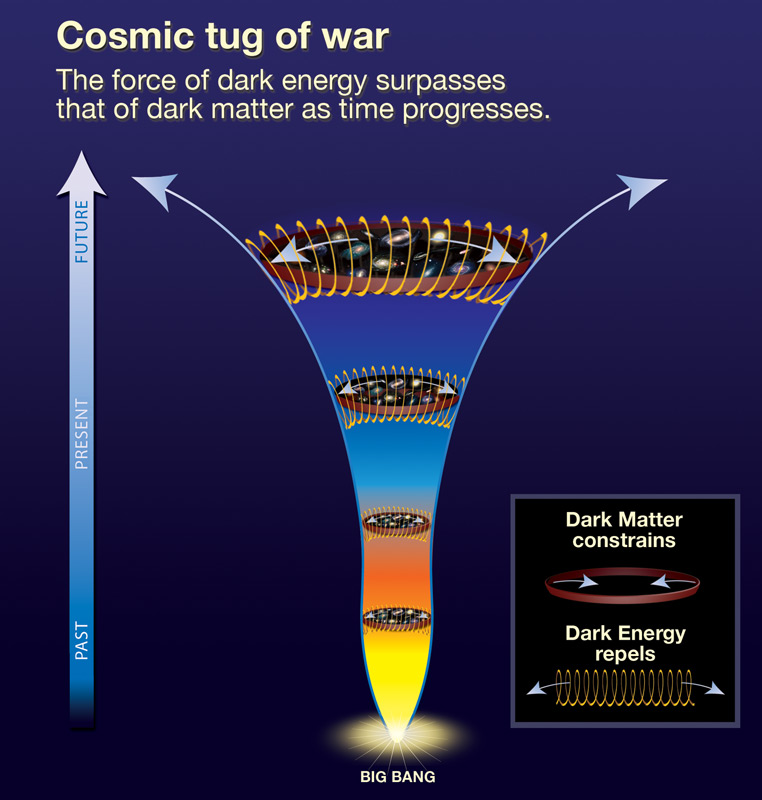Dark energy, a mysterious force believed to be responsible for the accelerating expansion of the universe, has captured the intrigue of scientists and cosmologists alike. Recent findings from the Dark Energy Spectroscopic Instrument (DESI) collaboration—featuring contributions from renowned researchers at Harvard—indicate that this enigmatic energy may actually be weakening over time, challenging our foundational understanding of the cosmos. Such dark energy research is pivotal, as it not only shapes our present knowledge but also holds the key to predicting the universe’s future. As researchers investigate the intricate balance between matter and dark energy, the implications of these dark energy findings could redefine our grasp of universal phenomena. In this exhilarating era of cosmic discovery, the DESI collaboration continues to illuminate the path toward understanding the vast and complex cosmos.
In the realm of astrophysics, the term ‘cosmological force’ can often refer to what is commonly known as dark energy. This elusive energy drives the expansion of the universe, prompting an ever-increasing interest in its characteristics and implications. Recent explorations through initiatives like the Dark Energy Spectroscopic Instrument (DESI) have unveiled critical details about how this driving force operates over time. As researchers compile vast 3D maps of our cosmos, they seek to grasp the underlying principles that dictate universe expansion and its potential impact on our future. The dialogues around the implications of these studies effectively enrich the overarching narrative of the cosmos.
Understanding Dark Energy: Insights from DESI Collaboration
Dark energy is a mysterious component of our universe that is believed to make up about 68% of the cosmos, yet its nature remains one of the biggest puzzles in modern astrophysics. Recent findings from the Dark Energy Spectroscopic Instrument (DESI) collaboration have the potential to reshape our understanding of this enigmatic force. According to researchers, dark energy may not be a constant entity as previously thought; instead, it appears to be weakening over time. This revelation suggests that our established frameworks for interpreting cosmic phenomena may need refinement to align with the evolving characteristics of dark energy.
The implications of these findings extend far beyond immediate observations. By analyzing a vast amount of data from over 14 million galaxies and quasars, the DESI collaboration illuminates how dark energy influences the universe’s expansion. This ongoing research sheds new light on past cosmic events and invites further exploration into the fundamental forces that govern the universe’s fate. The core of this investigation lies in understanding dark energy’s role in the universe’s further expansion or potential contraction in future scenarios.
The Expanding Universe: Dark Energy and its Implications
The universe has been expanding since the Big Bang, and the force behind this acceleration is widely attributed to dark energy. As scientists from the DESI collaboration delve deeper into the intricacies of the cosmos, their findings suggest that the mechanics of dark energy may be more complex than the simple model of a cosmological constant. This research raises questions about how dark energy interacts with visible matter and the underlying structure of the universe. In particular, the analysis of Baryon Acoustic Oscillations offers a unique perspective, revealing how the historical expansion of the universe has imprinted itself on matter distribution.
Understanding the role of dark energy is crucial not just for grasping the universe’s past but also for forecasting its future. As dark energy may be changing, scientists are tasked with exploring how it may affect cosmic evolution and the eventual fate of galaxies and clusters. This ongoing inquiry stands at the intersection of fundamental physics and cosmology, leading the way toward new discoveries that could redefine the narrative of cosmic expansion. Through the ongoing DESI surveys, researchers are piecing together this complex puzzle, which ultimately speaks to the fate of our universe.
Future of the Universe: Insights from Dark Energy Research
As we peer into the future of our universe, the revelations from dark energy research provide critical insights. With observations from the DESI collaboration, scientists are trying to paint a picture of what could await us billions of years down the line. The collaboration’s recent findings indicate not only a possible weakening of dark energy but also its effect on the rate of cosmic expansion. This foundational knowledge can alter our predictions about the universe’s ultimate fate, whether it leads to continued expansion, a leading to a ‘Big Freeze,’ or potentially a ‘Big Crunch’ where everything rebounds.
Such inquiries into the future depend on comprehensive datasets and robust theoretical models. The data generated by DESI serves as an invaluable resource for researchers, as it comprises detailed cosmic information that can validate or challenge existing theories. Moreover, as dark energy findings continue to evolve, they necessitate a broader dialogue within the scientific community regarding the future of the cosmos. Unlocking the mysteries surrounding dark energy is not merely an academic exercise; it fundamentally alters how we understand our universe’s destiny and defines humanity’s place within this vast expanse.
The Role of DESI Collaboration in Dark Energy Discoveries
The Dark Energy Spectroscopic Instrument (DESI) collaboration has made significant contributions to our understanding of dark energy, bringing together over 900 researchers from diverse institutions across the globe. This collaborative effort emphasizes the importance of interdisciplinary approaches to tackle complex cosmic questions. The mixed methodology employed, including state-of-the-art simulations and extensive data analysis, has led to critical findings that could change the trajectory of cosmic research. DESI’s comprehensive approach exemplifies how collaboration can yield insights that would be impossible for researchers working in isolation.
Moreover, the collaboration’s dedication to sharing findings widely enhances the scientific community’s ability to build upon DESI’s work. The incorporation of data release initiatives, like Release 1, offers researchers access to millions of celestial object measurements, facilitating a plethora of astrophysical studies. By fostering a culture of open science, the DESI collaboration not only advances dark energy research but also encourages global engagement in cosmos exploration, thereby creating a community of inquiry that continuously impacts the ways we study the universe.
The Importance of Baryon Acoustic Oscillations in Understanding Dark Energy
Baryon Acoustic Oscillations (BAOs) play a pivotal role in the field of cosmology, providing a snapshot of the early universe’s conditions and giving researchers a ‘standard ruler’ for distance measurement. The latest findings from the DESI collaboration have employed BAO measurements to gain insights into dark energy’s influence over billions of years of cosmic history. By analyzing the distribution and characteristic patterns of galaxies influenced by these oscillations, scientists can infer important details about the expansion rate of the universe and dark energy’s evolving dynamics.
The application of BAOs in dark energy research exemplifies how studying past cosmic events can yield valuable information about the present and future universe. Understanding the subtleties of these oscillations enhances the statistical models used to evaluate dark energy’s characteristics, thus contributing to a more nuanced comprehension of how the universe is expanding. This integration of BAO analysis into dark energy studies not only cements the importance of historical cosmic events in shaping our understanding of the universe but also highlights the interdisciplinary nature of modern astronomical research.
How DESI Utilizes Data for Cosmological Insights
The DESI collaboration has effectively harnessed the power of data to enhance our understanding of cosmological phenomena, particularly regarding dark energy. The extensive dataset compiled by analyzing over 14 million galaxies and quasars provides a wealth of information that scientists can utilize to unravel the complexities of the universe’s structure and expansion. By employing innovative algorithms and simulations, researchers are able to visualize and interpret this data in ways that allow for more precise measurements of cosmic distances and the effects of dark energy over time.
Moreover, the ongoing nature of the DESI survey means that new data is continually being collected, lending to an ever-expanding cosmic map. This dynamic asset enables scientists to track changes and infer relationships among different cosmic components, driving advancements in both observational and theoretical astrophysics. The ability to combine various datasets further enriches cosmological analysis, underscoring how data-driven research is foundational to achieving breakthroughs in our understanding of dark energy and the universe as a whole.
The Role of Public Engagement in Dark Energy Research
As the DESI collaboration progresses with its dark energy research, the role of public engagement has become increasingly vital. Education and outreach initiatives, led by members like Claire Lamman, are instrumental in demystifying complex findings and making them accessible to the general public. Creating visual aids and educational materials invites broader understandings of dark energy, the universe’s expansion, and cosmic evolution, fostering a culture of curiosity and interest in astronomy and space science.
Public engagement serves not only to inform but also to inspire the next generation of scientists and enthusiasts. By offering insights into current research endeavors, like those surrounding dark energy, DESI encourages younger audiences to look towards careers in science, technology, engineering, and mathematics (STEM). Furthermore, as the findings on dark energy become available, communicating their significance allows the public to appreciate and contemplate their implications, ultimately bringing a sense of shared stewardship in the exploration of our universe.
The Future of Dark Energy Research: What’s Next?
Looking ahead, the future of dark energy research appears promising as new technologies and methodologies continue to develop. The DESI collaboration’s ongoing surveys promise to expand our knowledge base far beyond the limits of current understandings. With ever-improving data resolution and analytical tools, researchers are set to uncover deeper layers of complexity regarding dark energy’s role in cosmic expansion and the structure of the universe. This evolving picture of dark energy, including its potential variations over time, may guide scientists toward breakthroughs that fundamentally alter their approach to cosmology.
In tandem with technological advancements, interdisciplinary collaborations will remain pivotal in addressing the many questions that dark energy raises. By uniting theoretical physicists, observational astronomers, and computational specialists under the same research umbrella, the scientific community can leverage a multi-faceted approach to explore uncharted territory within the cosmos. Ultimately, the continuing quest to understand dark energy not only aims to provide answers but also poses new inquiries about the very nature of existence, pushing the boundaries of human knowledge.
Frequently Asked Questions
What is dark energy and how does it relate to the universe’s expansion?
Dark energy is a mysterious force that makes up about 68% of the universe and is believed to be driving its accelerating expansion. It is often referred to as a ‘cosmological constant’ and plays a crucial role in current dark energy research, influencing how galaxies move apart over time.
How does the Dark Energy Spectroscopic Instrument (DESI) contribute to dark energy research?
The Dark Energy Spectroscopic Instrument (DESI) contributes significantly to dark energy research by creating the largest 3D map of the universe, which helps scientists understand how dark energy affects the universe’s expansion. This collaboration, involving over 900 researchers, is vital for examining the distribution of matter and dark energy’s impact across billions of years.
What are the latest dark energy findings from the DESI collaboration?
Recent findings from the DESI collaboration suggest that dark energy may be weakening over time, which could necessitate an update to the standard model of cosmology. This discovery was made by analyzing data from over 14 million galaxies and quasars and may change our understanding of the universe’s fate.
How are dark energy findings measured through Baryon Acoustic Oscillations?
Dark energy findings are measured using Baryon Acoustic Oscillations (BAOs), which are patterns in the distribution of matter created during the universe’s early moments. By examining these patterns, scientists can determine the effects of dark energy on the expansion rate of the universe at various distances.
What role does the CfA play in dark energy research through DESI?
The Center for Astrophysics | Harvard & Smithsonian (CfA) plays a pivotal role in dark energy research through the DESI collaboration. It provides key algorithms and simulations that enhance the analysis of dark energy’s effects on the universe’s structure and expansion, with contributions from many researchers in the team.
What does the future of the cosmos look like according to dark energy research?
The future of the cosmos, as suggested by recent dark energy research, may involve a changing dynamic of the universe’s expansion. If dark energy continues to weaken, as indicated by DESI findings, this could lead to new insights and a potential reevaluation of the universe’s ultimate fate.
How can the public access the data released by the DESI collaboration?
The public can access the data released by the Dark Energy Spectroscopic Instrument (DESI) collaboration through its Data Release 1, which is available online. This dataset offers detailed information about millions of celestial objects for further astrophysical research.
How does the DESI collaboration’s work impact our understanding of galaxy evolution?
The DESI collaboration’s work significantly impacts our understanding of galaxy evolution by providing ongoing data that helps analyze the formation and evolution of galaxies, the cosmic web, and the structure of our Milky Way, thus deepening our comprehension of the universe.
| Key Points |
|---|
| The Dark Energy Spectroscopic Instrument (DESI) is collecting data on dark energy’s influence on the universe. |
| Recent findings suggest that dark energy may be weakening over time, challenging existing cosmological models. |
| The analysis is based on the largest 3D map of the universe, using data from over 14 million galaxies and quasars. |
| Baryon Acoustic Oscillations serve as a standard ruler to measure dark energy’s strength through history. |
| Research teams from Harvard, led by Prof. Daniel Eisenstein, significantly contributed to the latest findings in the DESI collaboration. |
| The DESI project consists of over 900 researchers from more than 70 institutions worldwide. |
| Ongoing DESI surveys enhance understanding of galaxy evolution, the cosmic web, and the structure of the Milky Way. |
Summary
Dark energy is a crucial concept in modern cosmology, driving the accelerating expansion of the universe. Recent research from the Dark Energy Spectroscopic Instrument (DESI) collaboration reveals that dark energy might not only be real but also changing over time, which poses significant implications for our understanding of the universe’s fate. With an expansive dataset analyzing over 14 million galaxies, findings indicate that dark energy’s strength could be weakening, requiring a fundamental reevaluation of current cosmological theories. Consequently, this ongoing investigation into dark energy is critical for astrophysicists looking to enhance their comprehension of cosmic dynamics.



